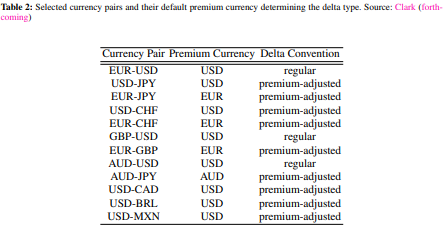Since FX is all OTC, you can never be sure about the details unless you ask your broker. Generally though, in order to maintain liquidity there are a number of standardized conventions. Unfortunately, these conventions vary between currency pairs. Usually, vanilla EURUSD options are not premium adjusted.
If you have access to Bloomberg, you can check on OVDV - 92)Settings->Conventions. Wystup and Reiswich, 2009 also have an overview of the most commonly used conventions.

The values are quick to replicate:
- For CCY1CCY 2, you have Notional in CCY1 (20MM) and Premium in CCY2 (USD)
- You have a deferred (forward) premium, therefore I use two dates (see here for an explanation)
- all other inputs are given
- The model is just standard Garman Kohlhagen
- all inputs are provided in the question
In Julia, this looks as follows:
#load packages
using Distributions, Dates, DataFrames, PrettyTables
#define helper functions
ppf(x) = quantile(Normal(0.0, 1.0),x)
N(x) = cdf(Normal(0,1),x)
#define GK
function GK(F,K, days_to_expiry, days_to_delivery ,ccy1, ccy2,σ)
d1 = ( log(F/K) + 0.5*σ^2*days_to_expiry/365 ) / (σ*sqrt(days_to_expiry/365))
d2 = d1 - σ*sqrt(days_to_expiry/365)
c = exp(-ccy2*days_to_delivery/365)*(F*N(d1) - K*N(d2))
δ_spot = exp(-ccy1*days_to_expiry/365) * N(d1)
δ_fwd = N(d1)
return c, δ_fwd, δ_spot
end
The inputs are all given, but the days to expiry and delivery are computed. I allow for hours to expiry but that is irrelevant here (the computed price is below the quoted, and delta would increase with increasing time).
# inputs
s = 1.0615
pts = 60.1
fwd_scale = 10^4
f = s + pts / fwd_scale
println("Forward = $f")
k = 1.101
σ = 0.089
ccy1 = 0.0255008 #0.0255 # EUR
ccy2 = 0.0478 # USD
price_dt = Date(2023,3,16)
premium_dt = Date(2023,6,20)
expiry_dt = Date(2023,6,16)
delivery_dt = Date(2023,6,20)
hours = 0 #0.7115 allows to get more accurate pricing but more hours to expiry would be needed (increases delta)
days_to_expiry = (expiry_dt - price_dt).value + hours/24
days_to_delivery = (delivery_dt - premium_dt).value + hours/24
r1_cont = log(1+ccy1*days_to_expiry/360)/(days_to_expiry/365)
r2_cont = log(1+ccy2*days_to_expiry/360)/(days_to_expiry/365)
I am omitting PrettyTables formatting. Essentially, I compute strike for 25D according to Wystup and Reiswich, 2009 (omitting the call/put flag φ because we only care about calls here):
$$ K = fe^{-N^{-1}(e^{rf\tau} * \delta_{s})*\sigma* \sqrt{t} + \frac{1}{2}*\sigma^{2}*\tau }$$
or for forward delta:
$$ K = fe^{-N^{-1}(\delta_{f})*\sigma* \sqrt{t} + \frac{1}{2}*\sigma^{2}*\tau }$$
δ = 0.25
# compute strike from delta
k_25D = f*exp((1/2)*σ^2*days_to_expiry/365 - ppf(δ*exp(r1_cont *days_to_expiry/365))*σ*sqrt(days_to_expiry/365))
# get option value for computed strike and quoted strike
opt = [GK(f, strike, days_to_expiry, days_to_delivery, r1_cont, r2_cont, σ) for strike in (k, k_25D)]
# get spot premium
premium_dt_spot = Date(2023,3,20)
days_to_delivery_spot = (delivery_dt - premium_dt_spot).value + hours/24
opt2 = [GK(f, strike, days_to_expiry, days_to_delivery_spot, r1_cont, r2_cont, σ) for strike in (k, k_25D)];
Notional = 20_000_000
df = DataFrame("Strike" => [k, k_25D],
"Fwd Premium USD" => [opt[1][1]*Notional, opt[2][1]*Notional ],
"Spot Premium USD" => [opt2[1][1]*Notional ,opt2[2][1]*Notional ],
"Fwd Delta" => [opt[1][2]*100 , opt[2][2]*100 ], "Spot Delta" => [opt[1][3]*100, opt[2][3]*100] )
The output matches Bloomberg exactly:

Using the computed spot delta of 25.0124 returns the strike (1.101):
DataFrame("Delta" => [δ, opt[1][3]], "Strike Solved" => [k_25D, f*exp((1/2)*σ^2*days_to_expiry/365 - ppf(opt[1][3]*exp(r1_cont *days_to_expiry/365))*σ*sqrt(days_to_expiry/365))])

P.S.
If it were premium included, you would not be able to use a closed form solution and would need to solve for strike numerically - for example, using Brent's root-finding method as suggested by Wystup and Reiswich.
However, since you directly want the Bloomberg values, you can simply use the API for a convenient solution that matches OVDV by design.